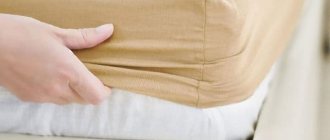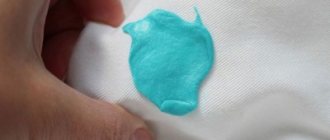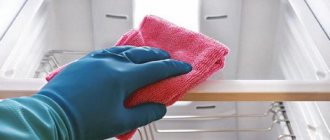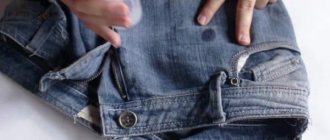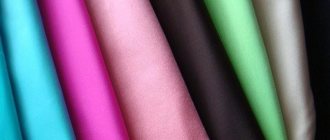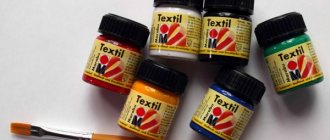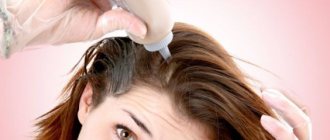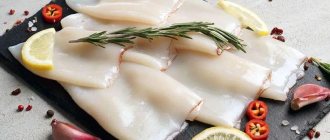Beginning artists and painters often ask whether acrylic paint can be coated with wood varnish, and what varnish is best for acrylic paint? This is an interesting, important question. Of course, a formulation specifically formulated for use with acrylic film is more desirable than a regular wood varnish (such as the kind you might use on furniture or floors). But if your passion for painting or decorating is just a hobby, then you can use it to apply it to wood painted with acrylic paint. This will save some money, but over time this film may turn yellow.
Preliminary testing
Before you begin the process of fixing the dye, you need to understand whether there is such a need. You can check its stability in several ways:
- Wet a piece of fabric that usually comes with clothes, or a small section of the item in the seam area, and then iron it through white paper. If there are colored stripes left on the sheet, the material sheds.
- Immerse the piece of material in ammonia for a few minutes, and then let it dry. Has the color faded? It makes sense to treat with a fixative.
- Roll the fabric or garment with a roller and then wrap it in a piece of white cotton. Immerse the bundle in the washing solution for 15-30 minutes. If the cotton is dyed, the color must be fixed on the fabric.
To check the fastness of the dye on denim, just press it with a damp cloth.
Peculiarities
Acrylic varnish contains dispersion and other substances that allow not only to treat the wood with an even layer, but also protect it from certain harmful influences. This refers not only to the consequences of the vital activity of microorganisms, but also to all kinds of climatic influences: increased dryness or humidity, for example. This varnish itself has the texture of thick sour cream, but it is more viscous. The classic color is delicate milky.
The product has many advantages, including the following.
- Safety. Acrylic varnishes contain no toxic elements. Some of them can even be used to paint dishes.
- Durability. High-quality varnishes do not wear off much over time, reliably protecting wooden surfaces for many years.
- Ecological cleanliness. Not to say that all the elements included in the varnish are natural, but it decomposes and does not harm the environment.
- Practical convenience. Lacquer surfaces are easy to care for, especially if they have increased strength characteristics.
- High functionality. Varnishes are used to perform various coatings on wood, from painting tableware elements to treating terraces and gazebos.
- Aesthetic appeal. Wood coated with acrylic paints and varnishes looks presentable. Its color and texture deepen, the texture appears more clearly
- Ergonomics. This means achieving optimal performance with low material consumption. For example, having applied only two layers, you can limit yourself to only them, since the wood will already look good.
- High elasticity. As the varnish hardens, it forms a protective film that cannot be removed in the future.
- High strength characteristics. Even with a high level of stress, the varnish coating will never be completely erased.
- High adhesive properties. The varnish has good adhesion to the original surface, which is why such high strength is achieved.
- Unnoticeable smell. Many consumers note the presence of a faint odor, similar to that produced by ordinary gouache. Epoxy and other paints and varnishes cannot be compared.
- Short time required for setting and drying. As a rule, applying several layers of varnish can be done within one daylight hours.
- Resistance to microorganisms. Acrylic varnishes clog the surface of the wood, preventing plant spores or bacteria from penetrating into it.
- Resistance to adverse climatic conditions. This also refers to the microclimate of the room. For example, varnish material can protect wood from cracking in a room with dry, warm air.
- Affordable price. The price of acrylic paints and varnishes cannot be called excessively high; rather, it is at an average level.
- Ease of operation. Several tools are suitable for application: the varnish is not very capricious in this regard.
In addition to its advantages, the material also has some disadvantages.
- The need for special temperature and climatic conditions during application. Do not apply varnish if the temperature is below +5 degrees or above +30 degrees. The technology will be broken, and the paintwork will not be guaranteed to be durable. You also need to avoid drafts.
- Need for special storage. Do not freeze or cool the material at all, or expose it to sunlight.
The sequence of fixing colors on clothes
To fix the paint on the fabric, you need to do the following:
- Wash a worn item in the usual way, and soak a new item for a quarter of an hour in clean water.
- Pour cool water into a container and mix it with the substance chosen to fix the paint.
- Immerse an item of clothing or material in the solution for no more than half an hour.
- Lightly wring out the fabric and rinse the item several times in clean water to remove the smell of the fixative. The air conditioner cannot be used.
- Dry the clothes in the open air and then iron them inside out. Regardless of the density of the material, do not turn on the “steaming” function.
Kinds
Initially, all acrylic varnishes are divided into two large groups: one-component and two-component. One-component varieties contain only acrylic; two-component ones are also characterized by the presence of polyurethane.
It is worth noting that two-component varnishes guarantee higher strength, which is why they are most often chosen for external work.
The most popular are water-based acrylic varnishes. They are increasingly replacing conventional varnishes for coating furniture. Acrylic scuba tanks have become so popular because, compared to other products that are also water-based (alkyd, for example), they are cheaper.
The other side of the coin is strength characteristics. They cannot be called elevated. As a result, such varnishes are not used outdoors.
They are only suitable for painting floors and furniture, but it is important to comply with all requirements regarding working conditions with the paint and varnish material indicated on the packaging. Usually refers to temperature and humidity
Two-component acrylic-polyurethane varieties, despite almost the same price, have higher strength properties than their one-component equivalent. However, you should not use this variety outside the room: it is not suitable for outdoor work.
Acrylate varnishes, also classified as acrylic, have a slightly expanded range of application. So, with their help you can not only tint and give a glossy shine to clean wooden surfaces, but also apply them to already painted elements
It's important to keep one thing in mind here. The paint used for painting must also be water-dispersed, otherwise the varnish will not adhere properly
There are few types of acrylic varnishes, but each of them is universal. If necessary, you can use each of them for exterior decoration, but only under the condition that you live in a temperate climate zone without extreme weather conditions. Otherwise, the paint and varnish material will not withstand and will simply crack, losing the lion’s share of its performance properties.
Color fixers
To make the color of the material more stable, use available fixatives from the kitchen and from the home medicine cabinet, which are dissolved in 10 liters of water. The choice of product depends on the type of material from which the product is made.
- A universal color fixer is vinegar. For soaking, dilute 100 ml of 9% table vinegar or 1 tbsp in water. l. 70% essence.
- 3 tbsp poured into water will help preserve the color of any material. l. lemon juice.
- For cotton, viscose and linen, table salt is used. If the fabric sheds a lot, you will need 10 tbsp. l. If the color is more durable - half as much. A mixture of salt and soda in a 1:1 ratio also gives good results.
- Shedding wool and silk clothes are treated with a warm glycerin solution. For the indicated volume of water you need 20 tbsp. l. There is no need to wring out or rinse the products after this.
- Shedding of knitted items can be prevented with dry mustard. Half a glass of powder is poured into a bag made of thin cloth and placed in a container of boiling water. When the water has cooled, the bag is pulled out and the colored product is soaked.
If the item is small, you can soak it in cooled potato broth to fix the color.
Different varnishes are needed, different varnishes are important
In its most general form, varnish is a liquid solution of various resins, which is applied in a thin layer to various surfaces and, after drying, gives them shine and protection from external influences. With the help of varnishing, a significant aesthetic effect is achieved, the service life of many products and the durability of repairs are increased. Varnish compositions are very diverse in terms of area of use:
- Furniture - used indoors to cover any wooden products (not just furniture); they often act as a finishing layer after sealing cracks in a log. They may contain coloring pigments immediately or be supplemented with tinting before use, thereby immediately giving the wood the desired shade during the varnishing process. They are economical in cost, but have low wear resistance;
- Parquet. Used on floors made of natural wood, including factory-treated floors. Parquet varnishes are compatible with parquet itself, solid boards and ordinary floorboards. Their cost is quite noticeable, as is their high abrasion resistance. The common property of furniture and parquet varnishes is low moisture resistance - this is why it is recommended to wipe parquet, furniture and varnished floors with mastic or special compounds, and not wash them with buckets of water;
- Yachting. They are the antipodes of their predecessors in terms of moisture resistance, because they can resist prolonged exposure to sea spray, salty winds and ocean waves for a long time. They are used not only in shipbuilding, but also in land-based household repairs, for example, when varnishing garden furniture, gazebos, stands for wooden canopies or carved trim outside windows. The cost of yacht varnish is several times higher than the price of parquet varnish, so it must be used wisely and carefully;
- Universal or decorative. They occupy an intermediate position between the above-mentioned compositions, allow application indoors and outdoors, and have moderate durability and cost.
Fixing acrylic paint
The color of the drawings, independently applied to the fabric with acrylic paint, also needs to be fixed. To do this, the fabric is exposed to high temperature. There are different ways of doing this.
- When the image is completely dry, the product is ironed from the wrong side. If the material is delicate, then you need to iron it through gauze.
- Bring water to a boil in a large saucepan and then hang the dyed fabric over the steam.
- Cover the baking sheet with parchment and place the product with the image on it. After this, the baking sheet is placed in the oven, heated to 150°, for a quarter of an hour.
- The product, painted with acrylic paint, is wrapped in cotton fabric in the form of a tube. The bundle is folded in half and the edges are secured with twine, and then wrapped in cellophane. Pour water into the steamer (it should rise 3 fingers above the bottom), put the bag with the item and close the lid. When the water in the pan boils, turn the fire to minimum power and steam the package for half an hour. After the steamer has cooled, the fabric is taken out, soaked for a quarter of an hour in a washing solution, and then washed.
As you can see, it is quite possible to prevent color from fading from fabric at home. Fixers are cheap and can be found in every home. If things are handled correctly in the future, they will retain their brightness for a long time.
photo: depositphotos.com/belchonock
Peculiarities
The list of positive properties of varnish is quite wide:
- It can be applied to almost any grease-free surface.
- It dries very quickly. However, the formation of a completely hardened, durable film will occur in about a week.
- It tolerates ultraviolet radiation well, without changing color or becoming yellow, maintaining the color palette of the surface being coated. Even direct sunlight does not cause its destruction.
- The use of colorless varnish will allow you to preserve the original color of the product, its saturation and brightness for a long time.
- Resistant to temperature changes.
- If necessary, it will add shine or matte.
- There is a huge assortment; any specialty store will provide a wide selection.
- Thanks to its water base, it penetrates deeply into wooden surfaces, protecting them from rotting, mold, mildew and pests, giving additional strength.
- Gives water-repellent properties.
- Not subject to fire.
- Protects from mechanical stress and damage.
- To obtain a specific tone on the product, any water-soluble paints can be added to the colorless composition.
- It has a high level of adhesion to the surface, due to which the surface film becomes especially durable.
- Chemically inactive, it is not affected by aggressive environments.
- Does not have a strong odor.
- Environmentally friendly, as it is made from harmless elements; does not release substances into the environment that poison the human body, and therefore can be used for finishing rooms where children often visit.
- Does not cause any difficulties in use.
- The surface coated with acrylic varnish is easy to care for - it tolerates household detergents well.
- Suitable for different types of work.
- Not subject to abrasion.
- It has high decorative qualities and reveals the wood texture.
- Used economically.
To obtain a stable coating, you must adhere to the following conditions when applying:
- the ambient temperature should be above +5°C and should not be heated above +30°C;
- the temperature of the varnish itself should not be lower than +15°C;
- before use, the composition should be stirred well until a homogeneous mass is obtained, since during storage it is possible that sediment may form from the varnish components;
- there should be no drafts during the procedure;
- the surface to be treated should not be exposed to direct sunlight;
- the surface before application must be thoroughly cleaned of dust, dirt and previous coatings;
- too low ambient temperature prolongs the drying time of the varnish;
- in very dry air, drying will occur too quickly, which can lead to the appearance of defects on the surface, causing swelling of wood fibers, which will require additional sanding and surface treatment.
Dry method
Not all beginning batik painters are aware that heat-set paints do not always “require” an iron. You can make the drawing eternal using a regular oven. Especially if your work is large or irregularly shaped.
The fabric must be rolled up and placed on tracing paper or baking paper directly on a baking sheet. Then turn on the oven and slowly heat it to 140 degrees, after which the product sits there for 10-15 minutes.
Another option: use a microwave for these purposes. I can’t tell you exactly what temperature and time to load the batik in there. This method requires experimentation, only after that I can tell you about it in detail.
Kinds
Depending on the composition, one-component and two-component varnishes are distinguished:
- In one-component versions, only acrylic is the binder, to which stabilizers, plasticizers, and antiseptics are added. One-component compositions are quite strong, the resulting transparent layer will effectively protect the wood from fading, deterioration, and mechanical damage. However, a constant humid environment will significantly shorten the service life and make the varnish less durable. Therefore, one-component compositions are more often used in decorative and applied arts rather than for covering floors and other surfaces subject to significant loads.
- In two-component compositions, the additional binder is polyurethane. Its addition increases the elasticity and strength of the final coating, resistance to mechanical loads, which makes it suitable for flooring in public places with a large influx of visitors.
Depending on the resulting decorative effect, the varnish can be matte, semi-matte, or glossy:
- Semi-matte gives the surface a smooth, non-shiny finish. After hardening, it has a silky texture, unevenness and defects on the surface become less noticeable.
- The product, coated with glossy varnish, acquires a bright shine. The use of a glossy composition requires an almost ideal surface, as all its imperfections will appear. Parquet is often treated with glossy varnish to achieve a “mirror effect”. Parquet varnish is inferior to matte in durability.
- Semi-matte combines the advantages and disadvantages of matte and glossy compositions. It will emphasize the texture of the product, give it a subtle shine and shimmer, but will also show surface imperfections.
Manufacturers
In construction markets, it is quite difficult to decide on the choice of paint and varnish material due to the wide range and large number of manufacturing companies.
There are several popular companies that produce quality products:
- Optimist is a large Russian manufacturer of paint and varnish products with a twenty-year history. The company strictly adheres to quality standards and uses high-quality materials in its work.
- VGT is a Russian company specializing in the production of varnishes, paints, enamels, pigments and other acrylic materials. The company has its own research center. Construction stores offer a wide range of products from this company.
- Tikkurila is one of the leading companies in the production of paints and varnishes in Finland, Sweden and Russia. Acrylic varnishes of this brand are in wide demand among consumers.
- Pinotex - the products of this company are famous for their quality, are in demand throughout Europe, and produce universal, waterproof, wear-resistant acrylic varnishes.
- "Lakra" produces parquet and tinted varnishes with a UV filter, the products have quality certificates.
